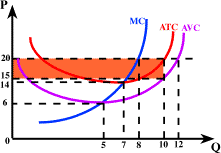As we learned before, unlike other costs, fixed costs will be
the same at any level of output. Therefore, in general, it doesn't matter
at what Q we compute them. However, in this graph the AFC curve isn't shown, so we have to figure out AFC as the difference between ATC and AVC. At an output level of 10 we happen to have both numbers, so this
is a reasonable way to compute fixed costs. In particular, we can
compute it as 10 x (20 - 15) = 50. This is represented by the shaded area.
Look at the graph at an output level of 7. When output is 7, ATC is 14. Even though it isn't marked we can conclude that AVC at 7 must be just slightly under seven, because fixed costs must
be the same everywhere, and 7 x (14 - 7) = 49, just slightly less than
50.

